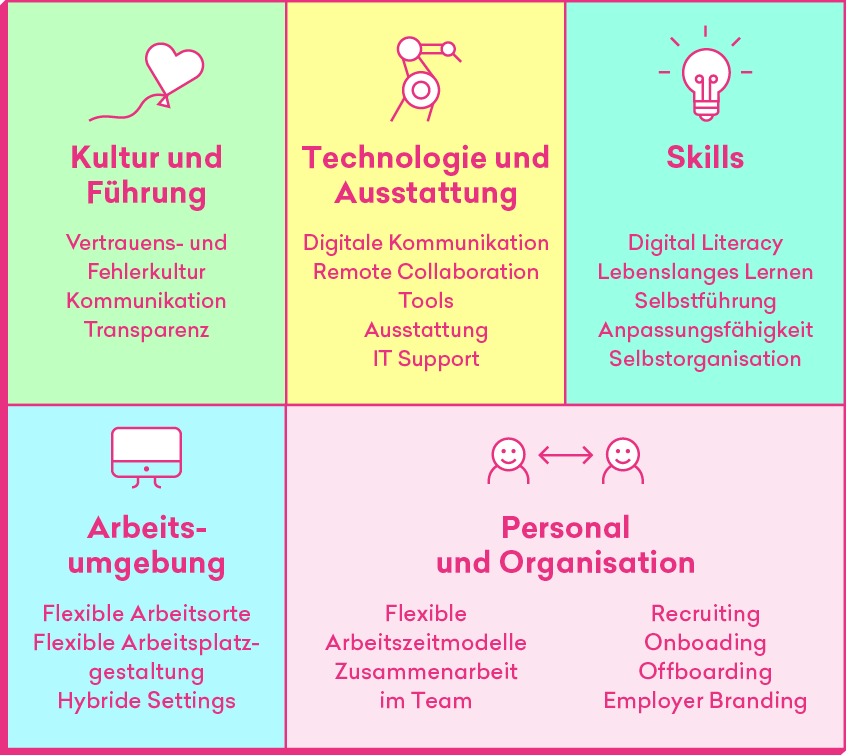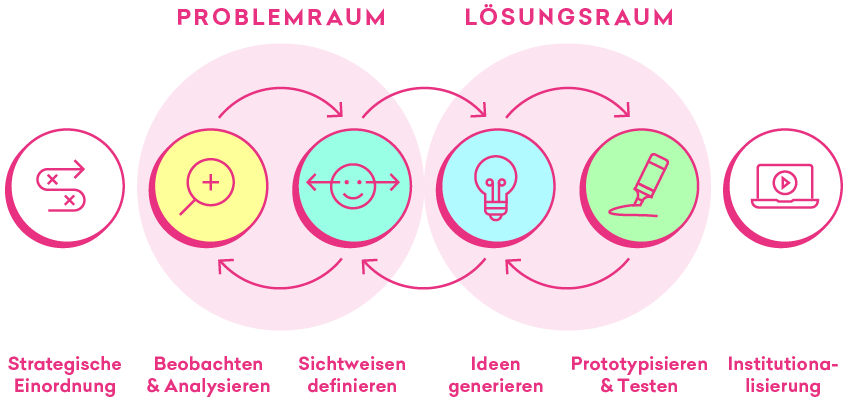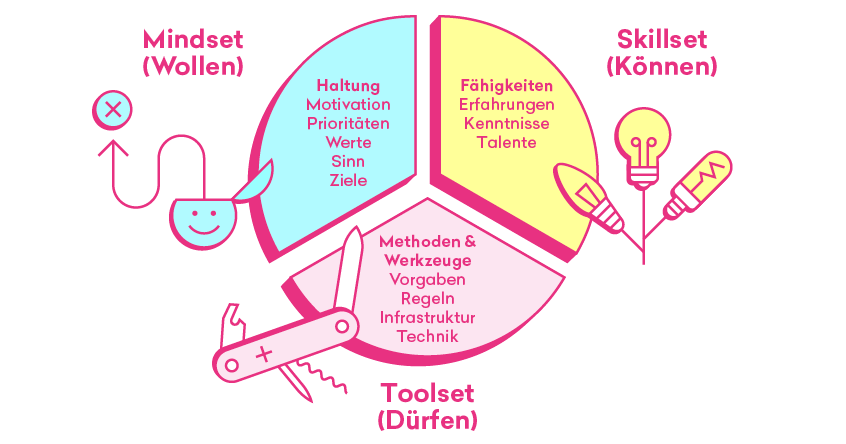What is New Work?

New Work, New Way of Working or Next Work is the answer to an increasingly digitalized and globalized world of work. Companies and organizations that ignore this change will not be relevant in a few years – neither for potential employees nor for customers. We will show you the concept behind New Work, the new ways of working that the New Work approach has brought about, and how business leaders can thrive in this new environment.
Content
Definition – what ist New Work?
Once derided as a buzzword and passing trend in the early 2000s, New Work has come to represent a new understanding of work, leadership, and everyday life in the face of digital transformation and a globalized workforce.
Also referred to as Work 4.0, Work of the Future, and Next Work, New Work brings together all the developments that are shaping our working world in the 21st century:
- The emergence of new professions and forms of work in the wake of digitalization.
- The dismantling of rigid structures and top-down hierarchies in favor of a flexible and agile corporate structure.
- The focus on employees as the most important factor for success.
- An increasing “blending” of work and private life (work-life blending or work-life integration).
- The integration of new technologies and digital tools into everyday working life.
The New Work approach breaks down professional boundaries and views social, demographic and cultural diversity not as a problem but as a competitive advantage. Strict hierarchies and top-down management are replaced by intrinsic motivation, self-actualization, and a new understanding of management and leadership.

The New Work concept according to Bergmann
The term New Work was coined by the social philosopher Frithjof Bergmann (1930-2021). In his treatise “New Work, New Culture: A Manifesto”, he outlines the need to redefine “work”. According to Bergmann, the industrial model of wage labor is no longer sustainable in our modern society: the paradigm shift from an industrial to a knowledge and information society must be accompanied by radically new forms and methods of work.
Bergmann formulated his concept between 1976 and 1979 under the influence of the socialist countries of the Eastern Bloc. The original concept of New Work is therefore based not only on the observation that socialism is not viable, but also on the realization that any future concept of work that is not based on self-determination and self-realization is also doomed to failure.
By definition, New Work does not focus on the productivity of a company or organization, but on people.
Why we need New Work
Why we need New Work We need a new concept of what “work” is because our world has changed. Thanks to digitalization and globalization, we now live in a world that is volatile, uncertain, complex, and ambiguous. Experts have coined the term “VUCA” (Volatility, Uncertainty, Complexity, Ambiguity) to describe this phenomenon. The changing environment presents organizations with both strategic and structural challenges.
At the strategic level, flexibility and the courage to fail are required: concepts are developed, tested, and evaluated with an eye on the market, the business environment, the customer base, and resources. Then the whole process starts again-only this time better! Modern strategy development is a never-ending process.
But where continuous innovation is required, the structural conditions and mindset must be right. Employees who stubbornly reproduce the same work processes from nine to five will not get the company or organization where it wants to be. What you need are people who are self-starters, who think creatively, and who love what they do. Similar to the OKR (Objectives and Key Results), management framework, the New Work approach creates a culture of “together, not alone.
New Work promotes innovative strength
In a New Work environment, employees are not motivated by their paycheck, but by the opportunity to flexibly combine work and private life, to develop their full potential, and to have a say in the direction of the company/organization. Combined with a positive culture of failure, this “new freedom” not only fosters a spirit of innovation in the sense of successful innovation management, but also creates the basis for targeted entrepreneurial thinking among employees: New work environments are an ideal breeding ground for intrapreneurship!

Is New Work the same as Work 4.0?
The terms New Work and Work 4.0 are often used interchangeably. In fact, they are not identical, but they are closely related. Work 4.0 primarily refers to the technological transformation of the world of work: when we talk about Work 4.0, we mean the consequences of digital transformation for our everyday working lives.
The advent of new technologies is changing the way we work – not just in industrial manufacturing, but in all professions. We work more digitally, we are more connected, and we are more flexible. However, this also means that work processes are changing and some job profiles are disappearing altogether, while new job profiles are emerging elsewhere. For this process of change to be successful, a fundamental adjustment of organizational and management structures is required. This is where New Work comes in:
While “Work 4.0” refers to the technological solutions that enable us to keep pace with digital change in our everyday working lives, “New Work” refers to the mindset shift that is needed to achieve it. New Work is both the establishment of a new corporate culture in response to digital change and a new value system that emerges from this change and leads to changed expectations of the world of work.
New ways of working and Gen Z
Changing expectations of what “work” means are most evident in Generation Z. While Millennials value flat hierarchies and flexible work schedules, those born between 1995 and 2010 go a step further: Gen Zers begin their job search with idealistic values. They are not primarily looking for a job, but rather a “purpose. Gen Zers want work that is meaningful and (also) serves a non-monetary purpose. In other words, they want their work to make a difference.
But unlike previous generations, who are often willing to trade idealism for a higher paycheck, Gen Zers hold companies and organizations accountable: They care that their goals and ideals are aligned with the company they work for. If not, the search continues.
The workplace as the center of life
It is not just the search for “purpose” in the world of work that makes Gen Z a new type of employee. More than any generation before them, Gen Zers are aware of a fact that Frithjof Bergmann has also pointed out: that the workplace has become the center of our lives in our culture. Not only do we spend most of our (working) lives at work, but we also make most of our social connections at work. The natural consequence of this development is that the boundaries between work and leisure are becoming increasingly blurred.
However, this increasing blurring of the boundaries between work and personal life also means that the workplace must adequately compensate for lost leisure time and create space for personal development and self-fulfillment.
In this way, Gen Z’s favorite phrase, the much-vaunted “work-life balance,” is losing its meaning: since “work” and “life” can no longer be neatly separated in the modern workplace, “work-life balance” is increasingly becoming “work-life blending”.
What is work-life blending?
New Work combines work and personal life to enable employees to achieve the highest possible level of self-fulfillment and self-determination in their daily work lives. Work-life blending means that the traditional sharp division between personal and professional life no longer applies. Personal phone calls or errands during working hours are no problem, as long as business emails are answered before 9 a.m. and after 5 p.m.
In addition, companies and organizations are increasingly creating leisure activities for their employees and developing flexible working time models.
While working from home has been standard practice in many companies since the coronavirus pandemic, New Work is characterized by a particularly high degree of workplace flexibility. Arrangements such as the four-day week, the six-hour day, or 100 percent remote work are not uncommon in a New Work environment.
New work? New corporate structure!
New Work breaks the boundaries of traditional “wage labor” and is incompatible with a classic top-down structure. However, the structures that a company or organization needs to establish on its way to a New Work approach do not only concern the executive level and (upper) management. The way people work together, work processes, and physical and technical structures must also be adapted to the new way of working.
New work requires new leadership
New work and Work 4.0 go hand in hand with a new concept of leadership. The concept of Leadership 4.0 is based on the recognition that traditional hierarchical leadership no longer works in our increasingly digital world of work. Leadership 4.0, also known as digital leadership, sees the key to success in the digital processes and tools that have become an integral part of our everyday work lives.
Digital leaders use new technologies to anticipate and respond to change. At the same time, leadership in the new work context is based on equality. Instead of dictating the path to be taken, the Leader 4.0 empowers employees to contribute to the company’s success in their own way.
(Re-)structuring the work environment
The New Work approach creates new freedoms for employees – and this is reflected in the spatial structures. We see two main dynamics at play: the reduction of traditional office space with fixed workstations, and the creation of new spatial solutions for new forms of collaboration. As the rise of home offices and remote working means that fewer fixed workstations are needed, the trend is towards open-plan offices, desk sharing and co-working spaces.
Technical structures and digital tools
Wherever people work remotely, they need to be connected. As a result, technical structures are an essential part of the transformation to the new workspace. In addition to the right hardware (e.g., laptops and phones), companies and organizations need to provide the right software for call routing and location-independent access to the internal network.
The right digital tools are also required to ensure that collaboration works remotely and/or in purely virtual teams. Collaboration tools such as MS Teams, Google Meet, and Slack enable regular communication over long distances. New work tools such as Trello, Confluence, and Miro are popular for project management.

Teamwork reimagined
In the new world of work, the goal is to eliminate siloed thinking and empower employees to reach their full potential. Both of these goals are virtually impossible to achieve within traditional departmental boundaries. So New Work breaks down the silos in favor of cross-departmental project work. The goal of these “mixed teams” is not only to bring together the necessary skills, but also to gain a heterogeneous perspective on the project at hand. The result: out-of-the-box thinking, new perspectives and innovative solutions.
We find an extension of this idea in the concept of the fluid team: Fluid teams not only break down departmental boundaries, but also regularly change their composition. The fact that new team members are constantly working on a project creates a particularly high level of ideas and innovation.
Another important issue related to new work is remote leadership. Remote leadership is especially important when teams communicate only virtually. While networking is usually not a problem and virtual teams can theoretically work together from anywhere in the world, a special kind of leadership is needed to ensure that not only the networking works, but also that the output is right.
Find out more about our remote leadership training now!
New ways of working at a glance
Agile work
New Work and agility are inextricably linked because they share the same fundamental principles. Agile transformation not only means moving away from rigid structures, top-down management, and strict departmental boundaries to flat hierarchies, autonomous teams, and flexible processes, but also promoting complete transparency and an open culture of communication and feedback.
Even in agile structures, the line between work and personal life is becoming increasingly blurred, as the personal development and advancement of employees is in the interest of the company/organization. Agile companies and organizations assume that a team member whose personal goals and values are compatible with those of the company/organization is happier and therefore more efficient.
Agile working enables short decision paths, flexible course corrections, and efficient, customer-focused product development. Agile working methods commonly used in agile project management include Scrum and Kanban. In product development, design thinking and future(s) thinking are popular agile working methods.
Mobile working
Since the coronavirus pandemic, we have learned that with good technical connectivity and good leadership, collaboration can work from anywhere! This has led to the development of a new way of working known as mobile working. While telecommuters are out of the office but still have a fixed workplace (at home), mobile workers are not tied to a specific location. This means they can work from anywhere: a coffee shop, a coworking space, or even the backseat of a minivan in the middle of the Grand Canyon National Park.
Crowdworking
A relatively new development in the wake of the new work dynamic is crowdworking. In crowdworking, companies/organizations do not work with a specific freelancer, but instead use online platforms to outsource work that does not require familiarity with the company’s structures.
The platforms, in turn, have a large network of freelancers who perform these tasks. In crowdworking, there is usually no personal contact between the company/organization and the freelancer or contractor.
Advantages and disadvantages of the New Work concept
Flat hierarchies, flexible working hours and more opportunities for personal development in the workplace – sounds great, doesn’t it? Unfortunately, as with any innovative concept, New Work comes with its own set of challenges:
Working from home or a minivan (mobile working) saves time and gives you more freedom. But it also requires a high degree of discipline and self-organization. Open-plan offices and the freedom to choose where you work can foster creativity and innovation. Without support and good leadership, however, changes of this magnitude can also trigger feelings of anxiety and resistance. Work-life blending can ensure that personal fulfillment and work life go hand in hand. However, it can also lead to overtime, increased pressure and mental burnout, as the separation between personal and professional life is ultimately important.
Conclusion on the New Work concept
The transition to an organization in which “New Work” works and is embraced by all stakeholders requires not only careful planning, but also a serious examination of corporate structures. “New Work is not a template that can be applied 1:1, but rather a concept that requires first and foremost a change in mindset and culture. Second, new ways of working and new methods lay the foundation for optimal collaboration in the new environment.

On the road to New Work with Wonderwerk

Wonderwerk Consulting is one of Austria’s leading providers of Work 4.0 and change management services. For many years, we have successfully supported transformation processes in companies and organizations of all sizes, providing the necessary outside perspective. As specialists in the process behind change, we not only have a theoretical understanding of how change management works, but also know the practical hurdles that companies and organizations have to overcome.
In the New Work transformation process, we work with you to analyze your organizational structure and internal processes: Are they up-to-date? Does your organization work efficiently? Do you know what your clients really want? Are you meeting candidates where they are?
We work with your strengths
Our goal with New Work is not to create a parallel universe within your company or organization. Our goal is to ensure that the new understanding of work, leadership, and daily life is embedded in the DNA of your organization, with everyone from top management to interns pulling in the same direction. To achieve this, we focus on your strengths: What is already working well? And how can we leverage that in the context of New Work?
New Work Design
The transformation to an organization that lives and breathes New Work is no easy process. This is partly because the change is open-ended: when we consult on New Work, we do not have a fixed end state in mind. Instead, we focus on working with you to create innovative outcomes that benefit both your organization and your people.
To do this, we rely on strategic design: we combine a systematic methodology with a focus on people – your employees and your customers. Our goal is to gradually eliminate outdated ways of working and thinking to make room for innovation. The end result is a win-win situation: employees enjoy a work environment that fosters their personal development and gives them new freedom. And customers get the products and/or services they really need.
New Work Success Story FSW
One of our success stories is the New Work Initiative, which we are implementing with the Vienna Social Fund (FSW). The aim of the initiative is to work with all employees to develop a shared vision of New Work at FSW while addressing current challenges. You can find the full success story here.
Why Wonderwerk?
Because we know that New Work looks different in every company/organization and that new ways of working and new working methods only make sense if they fit the company/organization. We guide you from the initial analysis through the planning and implementation of the change process and stay with you until the target state has become the new norm.
Contact
Anna-Maria Hausdorf
anna-maria.hausdorf@wonderwerk.com
Book a free consultation now!
Our New Work Trainings

New Work

New Leadership

Remote Leadership

Agile Coach








